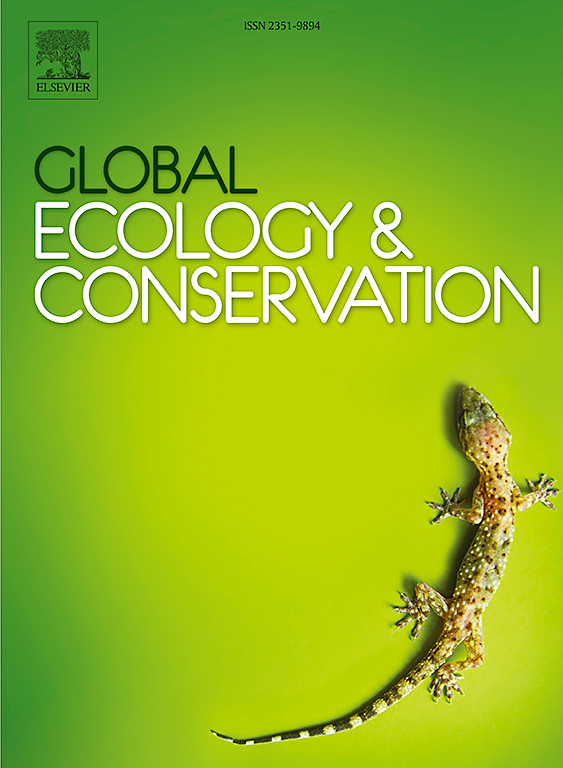Projecting the poleward habitat expansion of whale sharks (Rhincodon typus) in the west pacific and east Indian ocean in response to climate change
IF 3.4
2区 环境科学与生态学
Q1 BIODIVERSITY CONSERVATION
引用次数: 0
Abstract
Climate change is accelerating the poleward redistribution of marine megafauna, including whale sharks. This study aimed to (1) identify suitable habitat beyond the whale shark’s known northern range in the Northwestern Pacific, (2) quantify projected shifts in habitat across the Western Pacific and Eastern Indian Ocean under future climate scenarios using species distribution models (SDMs), and (3) examine the influence of key environmental drivers across ecologically distinct regions using SHapley Additive exPlanations (SHAP) analysis. High-performing SDMs were developed using H2O AutoML, incorporating presence records from GBIF, OBIS, and newly documented sightings in Korean waters. The best-fitted model was hindcast (2004–2023) and forecasted for the 2050s, 2070s, and 2090s using CMIP6-based Earth System Models under three climate change scenarios. Model projections indicated substantial habitat losses in equatorial regions and concurrent poleward expansion. Predictions illuminated suitable habitat within Korean waters to 47°N under present ocean conditions, extending to nearly 50°N by the end of the century, largely due to increases in sea surface temperatures. In contrast, chlorophyll-a played a more influential role in shaping habitat suitability in the Philippines and Ningaloo Reef, indicating region-specific environmental controls. While Korean waters may emerge as a future aggregation hotspot, the Philippines are projected to experience a persistent decline in high-quality habitat, and Ningaloo Reef may undergo seasonal shifts in aggregation timing. These findings highlight the ecological importance of emerging habitats and the urgency for proactive, region-specific conservation strategies in response to climate-driven range shifts.
预测鲸鲨(Rhincodon typus)在西太平洋和东印度洋的栖息地向极地扩展以应对气候变化
气候变化正在加速包括鲸鲨在内的海洋巨型动物向极地的重新分布。本研究旨在(1)确定西北太平洋北部已知鲸鲨活动范围以外的适宜栖息地;(2)利用物种分布模型(SDMs)量化未来气候情景下西太平洋和东印度洋栖息地的预测变化;(3)利用SHapley加性解释(SHAP)分析研究不同生态区域关键环境驱动因素的影响。高性能sdm是利用H2O AutoML开发的,结合了GBIF、OBIS的存在记录和韩国水域最新记录的目击事件。利用基于cmip6的地球系统模式对3种气候变化情景下的2050年代、2070年代和2090年代进行了最佳拟合后验(2004-2023年)和预测。模式预估表明,赤道地区的栖息地大量丧失,同时向极地扩张。预测显示,在目前的海洋条件下,朝鲜水域的适宜栖息地在北纬47°,到本世纪末将扩大到北纬50°,这主要是由于海面温度的升高。相比之下,叶绿素-a在菲律宾和宁格鲁礁的生境适宜性塑造中发挥了更大的作用,表明区域特异性环境控制。虽然韩国水域可能成为未来的聚集热点,但菲律宾预计将经历高质量栖息地的持续减少,而宁格鲁礁可能会经历聚集时间的季节性变化。这些发现强调了新兴栖息地的生态重要性,以及为应对气候驱动的范围变化而采取主动的、有区域特色的保护策略的紧迫性。
本文章由计算机程序翻译,如有差异,请以英文原文为准。
求助全文
约1分钟内获得全文
求助全文
来源期刊

Global Ecology and Conservation
Agricultural and Biological Sciences-Ecology, Evolution, Behavior and Systematics
CiteScore
8.10
自引率
5.00%
发文量
346
审稿时长
83 days
期刊介绍:
Global Ecology and Conservation is a peer-reviewed, open-access journal covering all sub-disciplines of ecological and conservation science: from theory to practice, from molecules to ecosystems, from regional to global. The fields covered include: organismal, population, community, and ecosystem ecology; physiological, evolutionary, and behavioral ecology; and conservation science.
 求助内容:
求助内容: 应助结果提醒方式:
应助结果提醒方式:


